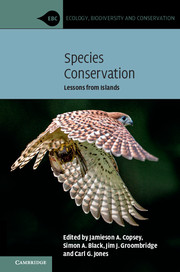Book contents
- Species Conservation
- Ecology, Biodiversity and Conservation
- Species Conservation
- Copyright page
- Contents
- Contributors
- Foreword
- Preface
- Acknowledgements
- 1 Species Conservation
- 2 Evolution on Islands
- 3 Island Populations
- 4 Threats to Islands
- 5 Documenting Change on Islands
- 6 Conservation Project Organisation
- 7 Managing Island Threats
- 8 Leading Species Recovery
- 9 Conserving Island Species
- 10 Restoring Island Ecosystems
- 11 Engaging Island Communities
- 12 Island Species Conservation
- Index
- Plate Section (PDF Only)
- References
2 - Evolution on Islands
Peculiarities and Implications for Species Conservation
Published online by Cambridge University Press: 15 June 2018
- Species Conservation
- Ecology, Biodiversity and Conservation
- Species Conservation
- Copyright page
- Contents
- Contributors
- Foreword
- Preface
- Acknowledgements
- 1 Species Conservation
- 2 Evolution on Islands
- 3 Island Populations
- 4 Threats to Islands
- 5 Documenting Change on Islands
- 6 Conservation Project Organisation
- 7 Managing Island Threats
- 8 Leading Species Recovery
- 9 Conserving Island Species
- 10 Restoring Island Ecosystems
- 11 Engaging Island Communities
- 12 Island Species Conservation
- Index
- Plate Section (PDF Only)
- References
- Type
- Chapter
- Information
- Species ConservationLessons from Islands, pp. 17 - 50Publisher: Cambridge University PressPrint publication year: 2018
References
- 1
- Cited by

